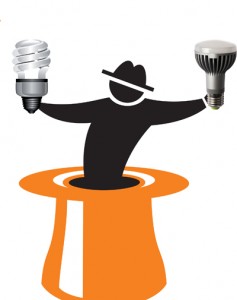 If you’re like most people, you’re still adjusting to using compact fluorescent lighting (CFL’s). They are those swirly light bulbs that look like a corkscrew. However, all sorts of green energy publications now tell us that we should be switching to solid-state lighting, a.k.a. led lighting systems. So which is better, LED or CFL? It depends on your unique needs, wants, and situation, however, here are some important facts to help you decide for yourself.
If you’re like most people, you’re still adjusting to using compact fluorescent lighting (CFL’s). They are those swirly light bulbs that look like a corkscrew. However, all sorts of green energy publications now tell us that we should be switching to solid-state lighting, a.k.a. led lighting systems. So which is better, LED or CFL? It depends on your unique needs, wants, and situation, however, here are some important facts to help you decide for yourself.
Availability:
CFL: CFL’s have almost taken over the shelf space at your local home improvement stores. You’ll have no problem finding CFL light bulbs for almost any type or style of light.
LED: You’ve probably seen LED’s in flashlights, movie theaters, and even now as headlights in some newer model automobiles, but not very often do you see LED’s used in the home. This has starting to change as LED lighting systems have become more popular. Most home improvement stores now carry home LED lighting kits, lamps, and bulbs, however, LED’s still cant compare, at this time, to the availability of CFL bulbs for home or office applications.
Cost:
CFL: Depending on the wattage and style of bulb, if purchased individually, prices can range from 50 cents to a 1 dollar for a standard 60w cfl bulb.
LED: Currently priced at around $9-$15 for a standard 60w LED bulb. That is much higher than a CFL, however it could be argued that the LED is LESS expensive when considering the longevity of the LED compared to a CFL, but we’ll get into that in just a bit. LED bulb prices are continually dropping and will continue to become more and more affordable in the future.
Energy Consumption:
According the governments Energy Star website, LEDs generate less heat and use less energy than CFL systems. The Department of Energy estimates by 2027, LED lighting systems could reduce electrical demand by 33%. They claim this could save $265 billion dollars, and result in 40 less power plants needing to be built.
Lighting Effectiveness:
While compact fluorescent lights emit light in all directions forming a sphere of light, LEDs only emit light in one direction with no wasted illumination to the sides and towards the fixture.
Life Expectancy:
CFL: Average Life Expectancy of about 6000 hours.
LED: Average Life Expectancy is about 25,000 hours
Other Pros & Cons To Consider:
- CFL’s require a warm up period, LED’s do not
- CFL’s can break easily and contain trace amounts of Mercury that require special precautions. LED’s are durable and contain no harmful substances.
- CFL’s are sensitive to extreme temperatures. LED’s are reliable in extreme temperatures.
- CFL’s can flicker and malfunction if when dimmed. LED’s offer smooth lighting performance when used with dimmers.
- CFL’s can continue to draw power even when turned off. LED’s pull no off state power.
Overall Summary:LED Lighting Systems are more efficient, durable, versatile and longer lasting than both incandescent and fluorescent lighting.
Of course a major factor in the durability, longevity, and overall performance of LED lighting is based upon how well they are designed and manufactured. Cheap Chinese manufactured knock off LED lights will not necessarily provide the long lasting and efficient characteristics mentioned in this article. When you purchase LED lighting for your home or office, make sure they come from a reputable manufacturer.





